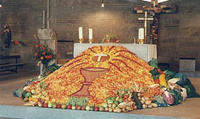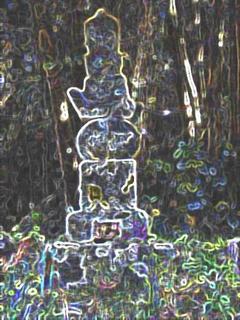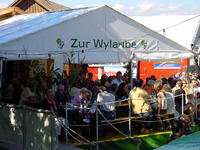BACKUP ONLY
The page has changed and is now here
http://washokufood.blogspot.com/2008/06/drinks-winter-saijiki.html
June 2009
[ . BACK to WORLDKIGO TOP . ]
:::::::::::::::::::::::::::::::::::::::::::::::::::::::::::::::::::::::::::::::::::::::::::::::::::::
Hot Drinks - SAIJIKI
***** Location: Worldwide
***** Season: All Winter
***** Category: Humanity
*****************************
Explanation
Hot drinks are extremely popular during the wintertime, when the warmth of the concoction and the warmth caused by alcohol are both welcome guests.
Hot alcoholic drinks are prepared in heat resistant glasses, and the alcohol must only be heated, but never allowed to boil or else the alcohol will dissipate.
For a more quickly prepared hot drink, alcohol can be combined with hot coffee, tea, hot water, hot wine, hot milk, or hot cream - but even in these concoctions, the liquor should be heated first if time permits.
Find a long list here:
© www.drinkstreet.com/
:::::::::::::::::::::::::::::::::::::::::::::::::::::::::::::::::::::::::::::::::::::::::::::::::::::
Some hot coffee drinks
Belgian Coffee
Café Amaretto
Café French
Café Brulot
Café Caribbean
Café Royal
Coffee Bustamante
Cafe Muerte
Hot Irish Nut
Hot Brandy Toddy
Irish Coffee
Jamaican Coffee
Mexican Coffee
Russian Coffee
Spanish Super-charged Coffee
Almond Hot Chocolate
Hot Buttered Rum
Hot Chocolate Almond
:::::::::::::::::::::::::::::::::::::::::::::::::::::::::::::::::::::::::::::::::::::::::::::::::::::
Chocolate Drinks
champurrado; also chocolate atole (Mexico and Mexican neighborhoods in large cities)
Traditional Mexican hot chocolate (from the Aztecs) flavored with cinnamon and thickened with corn meal; served in winter especially during posadas, a nine-day celebration of Mary and Joseph’s travel to Bethlehem, from December 16 through December 25. Atole is cornmeal mush or thin gruel that is flavored to make a Mexican drink.
hot chocolate also hot cocoa (worldwide)
Ovaltine (Switzerland, USA, and elsewhere) Ovomaltine is a Swiss milk product with chocolate and malt extracts by Wander AG, a subsidiary of Novartis Consumer Goods. It is known as Ovaltine in the USA and various parts of the world.
Coffee and Tea
chai (India and becoming worldwide)
Hot spiced tea blended with milk.
hot tea (worldwide) hot black tea, hot green tea
Irish coffee (Ireland, USA, and elsewhere)
Hot sweet rich coffee and Irish whiskey with cream floating on top.
milk tea (Mongolia)
Traditional drink of tea made with milk, not water. People usually put a little salt into the tea when they drink it. Sometimes, butter or stir-fried millet is added.
mulled tea; also spiced tea (widespread)
Hot tea made with sugar and spices.
Miscellaneous
anijsmelk (Netherlands)
This is hot aniseed milk. With the Dutch, it is as popular as hot chocolate.
hot milk (worldwide)
Milk which is simply heated; especially good with Christmas cookies.
Perhaps not a kigo for winter since it is used year round to promote sleep.
mulled cider; also hot spiced cider (USA and probably elsewhere)
Non-alcoholic cider heated with sugar and spices.
Mulled Wine
Wine heated with sugar, herbs, spices, and/or fruit. It is often fortified with other alcohol.
bisschopswijn; also bishop's wine (Netherlands)
Traditional beverage for Dutch Sinterklaas Eve--December 6.
gloeg (Norway

glögg (Sweden)
Traditionally served during six-week Advent season. The very best glögg is fortified with aquavit. All countries' gloggs go very well with gingerbread and gingersnaps.
gløgg (Denmark)
Traditionally served on Christmas day with apple dumplings that are topped with powdered sugar and strawberry marmalade.
glogg (USA spelling)
It is common to drink "glogg" in the USA; not everyone calls it mulled wine.
glögi (Finland)
Traditionally served during six-week Advent season
glühwein (Germany)
Generally lighter (alcohol and spiciness) than glogg.
vin chaud (France, Swiss Alps)
More like glühwein in flavor, but more frequently fortified with brandy that its German counterpart.
zbiten; also spelled "sbiten" (Russia)
An old Russian beverage made from of red sweet wine, honey, spices, and tea made of spearmint, melissa, and/or St John‘s wort. It is said to give great health, especially strength for men and beauty for women.
Posset (England)
Sweet spiced hot milk curdled with ale or beer. Is the forerunner of eggnog. Today, these are mainly historical drinks. In the past, they were often drunk for heath. Some were given to children to make them sleep.
Toddies
Drinks made of liquor and water with sugar, spices and often, citrus juice.
grog, grogg (England, Germany, Australia, USA, and possibly elsewhere)
Today grog is made of rum, sugar, spices, limejuice, and hot water. Originally, it was just watered down rum. In some places, the names grog and toddy are used interchangeably.
hot buttered rum (USA)
This drink is grog with a pat of butter melting on top
hot toddy (England, Germany, Australia, USA, and possibly elsewhere)
A hot drink (as above with any citrus juice) made with any alcoholic liquor except rum. Again, the names grog and toddy are used interchangeably in some places.
hot whiskey (Ireland)
Also called "hot Irish" and if you are in an Irish pub, just ask for "punch." Like other drinks in this category except made with Irish whiskey.
yuwari 湯割り (Japan)
Alcoholic drinks diluted simply with hot water
hot umeshu (Japan)
plum wine diluted with hot water
Wassail
Punch made of sweetened ale or wine heated with spices and roasted apples
wassail (England and elsewhere)
See above description. The word "wassail" is also a verb that means to celebrate noisily or to whoop it up.
lamb's wool (England)
Hot flavored ale (wassail) with a good amount of roasted apple pulp (lamb's wool) floating on top; served with Twelfth Day Cake on the feast of the Epiphany.
Ed Schwellenbacher, 2005
:::::::::::::::::::::::::::::::::::::::::::::::::::::::::::::::::::::::::::::::::::::::::::::::::::::
CIDER
hot cider; also hot apple cider (USA and probably elsewhere)
non-alcoholic cider which is simply heated, winter kigo
cold cider サイダー saidaa
kigo for all summer in Japan
fresh cider, frischer Apfelmost
kigo for autumn in Europe/Australia
Cider Daruma Label, a good luck drink ダルマサイダー
:::::::::::::::::::::::::::::::::::::::::::::::::::::::::::::::::::::::::::::::::::::::::::::::::::::
.. .. .. .. WKD ... more Hot Drinks
hotto dorinku ホットドリンクス hot drink
hotto uisukii ホットウィスキー hot whiskey
hotto wain ホットワイン hot wine (grape wine)
hotto remon ホットレモン hot lemon
mugiyu 蕎麦湯 (そばゆ) hot buckwheat water
shoogayu 生姜湯 (しょうがゆ) hot ginger water
:::::::::::::::::::::::::::::::::::::::::::::::::::::::::::::::::::::::::::::::::::::::::::::::::::::
kuzuyu 葛湯 (くずゆ) hot arrowroot water
うすめても花の匂の葛湯かな
usumete mo hana no nioi no kuzuyu kana
even if diluted
it still smells of the flowers -
hot arrowroot drink
Watanabe Suiha 渡辺水巴
:::::::::::::::::::::::::::::::::::::::::::::::::::::::::::::::::::::::::::::::::::::::::::::::::::::
Egg Nog
A punch made of sweetened and lightly spiced milk or cream mixed with eggs and usually alcoholic liquor.
Eggnog, also called "auld man's milk" in Scotland (worldwide)
See description above. Eggnog is usually served cold in the USA.
Tom and Jerry (USA)
This drink is a special eggnog that uses a batter of eggs, sugar, and spices wherein the eggs are separated, beaten, and then folded together with sugar and spices. Rum, brandy, and boiling water or milk are added to complete the drink. This drink is usually thicker than regular eggnog.
Hot Whiskey (toddy)
Mulled wine (gloegg, Gluehwein), Wassail, hot mead
honey wine, met
The word "mulled" simply means heated and spiced.
hot rice wine, atsukan 熱燗, kanzake 燗酒
see : Ricewine, rice wine (sake, saké, saki, Japan)
tamagozake 玉子酒 (たまござけ) 卵酒(たまござけ) and more
nezake 寝酒 (ねざけ) nightcup, before going to bed
Rumpot (Rumtopf) Germany (rum with fruits of the season)
*****************************
Things found on the way
*****************************
HAIKU
on my mind
through the birch--
a hot drink once home
beckoning to me
through frosty panes--
her face and a warm drink
prosit
Ed Schwellenbach
xxxxxxxxxxxxxxxxxxxxxxxxxxxxxxxxxxx
hot milk
for my bad fit of coughing
mum adds a whisky
a hot toddy
with a big cognac
his poor head
drink a hot toddy
and then take to your bed
does your head spin
Geert Verbeke
Read more haiku of Geert here:
http://happyhaiku.blogspot.com/2004/01/friends-geert-verbeke.html
*****************************
Related words
***** Frozen Drinks
kigo for Summer
Here is an external LINK with Frozen Coctails :
The hot days of summer call for really cold drinks and it cannot get colder than these blended cocktails. Most of these drinks are blended with ice but some use ice cream and they often include fresh fruit.
check this .. cocktails.about.com/od/cocktailrecipes
***** Iced Tea and Coffee
***** Black Tea and Coffe from Kenya
***** Things to keep you warm in winter, a KIGO list
WASHOKU : Shiru 汁 ... Soups Suppen
:::::::::::::::::::::::::::::::::::::::::::::::::::::::::::::::::::::::::::::::::::::::::::::::::::::
SPRING DRINKS ... SAIJIKI
SUMMER DRINKS ... SAIJIKI
AUTUMN DRINKS ... SAIJIKI
DRINKS SAIJIKI ... TOP
Back to the Worldkigo Index
http://worldkigodatabase.blogspot.com/
:::::::::::::::::::::::::::::::::::::::::::::::::::::::::::::::::::::::::::::::::::::::::::::::::::::






































